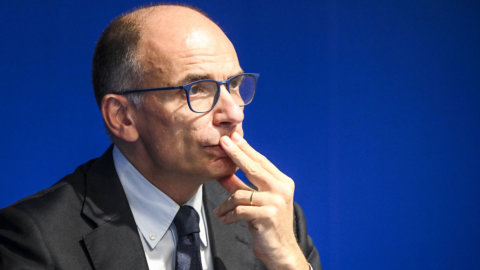When, in the play "The Importance of Being Earnest", Oscar Wilde wanted to represent the traits of late nineteenth-century English society between the hypocrisies of Victorian morals and a sense of triumph for imperial conquests, he found that references to the economic theme could serve more than others .
So he had Miss Prim make a heartfelt suggestion to her pupil: “Cecilia, during my absence you will continue reading the textbook on Political Economy. But when you get to the chapter on the fall of the rupee, leave it out. It's too exciting for a young girl."
And in fact the young girl, to be protected from particularly strong emotions, would have read of the devastating economic and social consequences of the collapse of the purchasing power of the Indian currency, linked to the silver heel, following the discovery of large mines of that metal and of the imposition of the Anglo-Saxon gold standard on the global economy. This dealt the final blow to the Indian economy, decreeing its definitive subjection to the British one.
Literary texts abound in references to economic laws, such as in this case to that of the supply and demand for money, a central topic in the vicissitudes of other historical periods, including the current one. Taken from reading the main events, the stories of the protagonists or other interpretative keys, however, we are inclined not to give them sufficient attention. Yet these, sometimes brief, references contain elements of context, which the authors often summarize, connecting precisely to the dominant economic thought in the times they write about and which prove to be extremely effective.
Going in search of it, commenting on and reclassifying its contents according to the major strands of economic analysis, is the objective of The richness of emotions, Economy and Finance in the masterpieces of literature, published by Carocci Editore (2015, pp. 311 , €. 31), by Giandomenico Scarpelli, manager of the Bank of Italy.
Before exposing some reflections on the usefulness of such an essay, it must be premised that it is divided, with some "claim to completeness", as the author himself says, into twelve chapters which collect references ranging from the laws of value and of production to the themes of liberalism and protectionism, from taxation to the economy of the environment, with an absolutely relevant part (the three central chapters) concerning the literary references to the themes of money, savings, financial investments, speculation and of the banks.
It would be simplistic to consider the work as a copious, cultured and articulated review, distinguished by the happy choice (for explanatory capacity) of over three hundred quotations from the great works of Western literature of the last three centuries and from equally important texts on economics
If the assonance with the Wealth of Nations by Adam Smith, the first work of modern economic thought, is captured in the title, the meaning of Scarpelli's work is to create suggestive transversality, bringing together different subjects such as literature and economics, and nevertheless capable of arousing emotions through the ability to reveal the traits of the human soul in the relationship with material riches.
A successful challenge to the well-known definition of sad Science, with which Political Economy is called. Thus, to cite a few examples, Emile Zola's "Money" speaks of the creation of a 'universal bank', which was to deal with all banking business, but above all to develop through the financing of large international projects, in support of which post the rapid growth of share values to always attract new investors. Financial skills lead to directors' conflicts of interest, manipulation of savers' good faith and governance concentrated in the hands of a few, with the compliance of the control functions and intolerance for any action to contrast the protagonist's ravenous appetite for risk , which recalls the characteristics of the speculations of modern "financial wolves" (and also of some more local bankers). After the first successes, the unreserved trust of the sovventori turns into doubts and suspicions about the outcome of the enterprise, until the final collapse, preceded by panic and the attempt to unload the failure on the alleged plots of the competitors...
In Federico De Roberto's "The Viceroys", Don Blasco, a religious exponent of the Sicilian Uzeda family, as well as a fervent Bourbon, lets himself be attracted by the prospect of speculating on the 5% Italian Rendita of the hated new Italian state, whose securities, traded at Paris Stock Exchange, also allow you to collect the coupon in francs, a currency convertible into gold, and therefore to benefit not only from the rise in prices, but also from the "legitimate" export of capital. It is an unsurpassed piece of literature in which the author shows that he has completely mastered the calculation of the effective yield on bonds and that he anticipates trends that have never died down in the subsequent Italian history of the almost endemic capital flight.
In "The Black Obelisk" by Eric M. Remarque recalls the death of money in the German hyperinflation of the early XNUMXs, describing the tragic conditions of its victims and the "crazy ideas" of the Reichsbank on how to counter it. The paradox is that the State, seeing the value of its debts disappear thanks to inflation, finds itself on the same side as the speculators who increase their real wealth, thanks to the hyperbolic monetary signs of banknotes that have now become waste paper.
Scarpelli's work, whose originality and perhaps even uniqueness must be highlighted, proves to be effective in the reconstruction of many emblematic events.
But the value of this approach can go beyond that of being an interesting essay, being able to contribute to the improvement of cognitive processes in the field of economics and finance, whose scarce predisposition by the general public is now singled out as a contributing cause of the spread of speculation, fraud and scams.
Without ever belittling the responsibilities of the perpetrators of the wrongdoings and of those in charge of controls, the book can be an excellent financial education "production" tool, to be suggested for the school age in which one approaches literature texts in a more complex and critical. Rereading its contents later can keep its educational purpose intact, to build generations with a more attentive financial culture.
In fact, we are of the opinion that the ability to fill the knowledge gaps of Italian savers cannot be the result of only a series of dry technical knowledge, which risks leaving the time they find, but methods which, in addition to focusing on information more transparent, can fix in the mind the value of deeper and more engaging reflections. Therefore, to prevent financial education from establishing itself as a trend of the moment (and perhaps also as a lucrative business opportunity), it must not, as was once said of the war, leave it to the exclusive prerogative of technicians; penetrating it through cultural tools, typical of other disciplines that sharpen the profiles of human sensitivity, can in fact increase the ability to judge and the spirit of discernment. Today it is above all the cinematographic art that has attempted to represent the characteristics of an era of particular financial aggressiveness, whose excesses we are still paying for, arousing emotions for topics that are in any case difficult to deal with under less technical profiles.
We could also make other considerations, such as that a given historical period can be identified only through the sublimation of its characteristics in artistic-literary manifestations. The quotations contained in the book help, for example, to dispel this doubt in relation to some periods that the literature even makes appear clearer and more emblematic than certain historical reconstructions. But we don't think we need to delve into such complex topics.
We would simply like to conclude that, for those commentators who like to close their reflections with some literary reference congruent with the technicalities commented from time to time, the possibility of having recourse to Scarpelli's very rich work proves really attractive.




